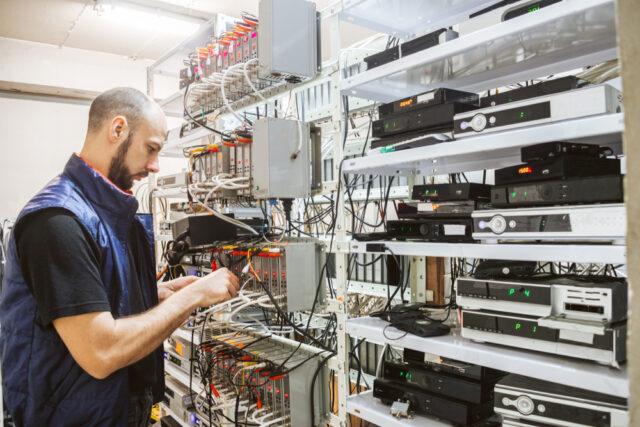
How to display the camera image on a monitor? 4 ways + Faceter
Users of the video surveillance system don’t always need to record a video file from a recorder. Sometimes it is enough to display the image from the camera on the monitor and watch it online. Such users need to know how to get a quality picture on the monitor. And the methods should take into account the possibility of displaying images from several cameras. That is what today’s article is about.
Real-time viewing. 4 ways
To view video from the monitored object in real-time, use the following solutions:
- Video camera with a monitor.
- BNC to HDMI converter.
- Video recorder with a connector for a monitor.
- A video multiplexer. It can also show multiple images on one screen.
Let’s look at each point in more detail.
The article “What should you not expect from legacy video monitoring systems?” is very useful.
Camera with a monitor
A camera with a monitor included is an automatic system and the easiest way of viewing video online. A BNC coaxial cable is used for the camera and monitor.
The connection process is as follows:
- The cable with BNC connectors provides power to the equipment and operation of the camera.
- A power cable is connected to the video input of the surveillance camera and the other end of the coaxial cable is connected to its output, where there is a BNC connector.
- A coaxial video cable is connected to the monitor via a BNC video input. The monitor is compatible with High Definition (HD) format. Plug the camera power supply into the electrical socket. Connect the power cable of the set to the power outlet.
BNC to HDMI Converter
With a BNC to HDMI converter, it is possible to use a standard TV with HDMI input as a monitor. Any HD BNC video camera can be connected to a monitor or HDMI TV.
The process is as follows:
- Use an HDMI cable to connect the converter and the TV (monitor). Use the HDMI output of the converter and the HDMI input of the monitor.
- The video surveillance camera is connected to the converter’s input using a coaxial cable with a BNC connector.
- The system works with any type of camera, such as dome, and street cameras, with or without IR illumination.
Detailed information and a 7-step tutorial can be found here.
Video Multiplexer
With the video multiplexer, it is possible to watch online the video of several objects on one monitor. Cooperation with HD cameras is available. Production of video multiplexer models with 4, 9, and 16 channels has been established. HDMI output enables connection to any TV.
The connection process and operating possibilities are as follows:
- The HDMI input of the television is connected to the HDMI output of the video multiplexer.
- The user has the possibility to switch between the picture from one camera to the picture from several cameras.
- Display on the screen is carried out with the wireless remote control or using a button on the equipment.
- An RG59-cable is used to connect the cameras to the multiplexer.
Output via video recorder
If your camera doesn’t display the picture on a monitor, then you should use a video recorder. Mobile apps allow you to watch video remotely.
HDMI and VGA monitor outputs let you configure the recorder independently. Models are also produced with 4, 9 and 16 channels. It is possible to set the signal for one or more cameras.
Faceter alternative
There is a great alternative to all of the above methods which is web-based video surveillance with Faceter. The team of the company provides professional functioning of the video surveillance system for business, home use, and security measures in public places.
The Faceter cloud-based video surveillance service (website https://faceter.cam/en) incorporates innovations from the surveillance market, thus continuously expanding the available functionality of the system. The use of any smartphone as hardware can significantly reduce the cost and simplify the installation and operation of the entire surveillance system.
Conclusion
Modern video surveillance systems crowd out old analog systems and reduce the number of parts in the equipment. Installation is becoming easier and the list of features is becoming longer. It is now possible to store a video archive in the cloud and have instant access to it. Take advantage of Faceter!














